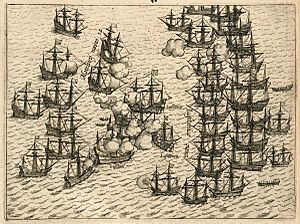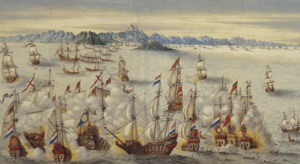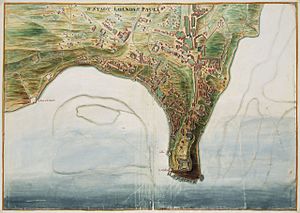Dutch–Portuguese War facts for kids
Quick facts for kids Dutch–Portuguese War |
|||||||
|---|---|---|---|---|---|---|---|
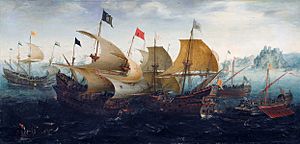 Portuguese galleon fighting Dutch and English warships |
|||||||
|
|||||||
| Belligerents | |||||||
Supported by:
|
Supported by:
|
||||||
| Commanders and leaders | |||||||
|
|
||||||
The Dutch–Portuguese War (also known as the Spice War) was a long conflict between the Dutch Republic and the Portuguese Empire. It lasted from 1598 to 1663. This war was fought all over the world, in places like the Americas, Africa, and Asia.
The Dutch forces, mainly the Dutch East India Company and the Dutch West India Company, tried to take over Portuguese colonies. For much of this time, Portugal was united with Spain under the Iberian Union. This meant the war was also connected to the Eighty Years' War in Europe, where Spain and the Netherlands were fighting.
However, the main reason for the Dutch–Portuguese War was for the Dutch to build their own overseas empire. They wanted to control the valuable spice trade. England sometimes helped the Dutch, but later they became rivals.
In the end, Portugal kept control of Brazil and Angola. The Dutch won in places like West Africa, Malabar, Malacca, Ceylon, and Indonesia. Portugal did manage to keep Macau.
Many Portuguese people felt that Spain had not done enough to protect their colonies. This feeling helped Portugal break away from Spanish rule in the Portuguese Restoration War. This war happened at the same time as the later parts of the conflict with the Dutch.
Contents
Why Did the War Start?
This war lasted a very long time, from 1598 to 1663. The main countries involved were Portugal and the Republic of the Seven United Provinces (the Netherlands).
From 1580, Portugal was ruled by the Spanish king, Philip II of Spain. He was also fighting against the Dutch in Europe. Before this, Portuguese merchants used Dutch ports to sell their spices. But when Spain took over Portugal, Philip II stopped all trade with the rebellious Dutch provinces.
To get their spices, the Dutch had to send their own ships to Asia. They wanted to take control of the spice trade themselves. This also happened after the Dutch helped the English capture the Portuguese colony of Recife in 1595.
Like France and England, the Dutch wanted to create a global trade network. They attacked many Portuguese and Spanish territories. These included places in Asia like Formosa, Ceylon, and the Philippine Islands. They also attacked trade interests in Japan, Africa, and South America.
The Spice Trade and New Companies
In 1592, an English fleet captured a large Portuguese ship called the Madre de Deus. It was full of goods from India and China, worth a huge amount of money. This showed how rich the East was and made many people interested.
That same year, Dutch merchants sent Cornelis de Houtman to Lisbon. He was to gather information about the Spice Islands. In 1595, an explorer named Jan Huyghen van Linschoten published a travel report. It had detailed maps and directions on how to sail between Portugal and the East Indies.
This new information made the Dutch and British want to expand their trade. So, the English East India Company was started in 1600. The Dutch East India Company (VOC) was founded in 1602. These companies were given special rights to trade in the East Indies.
The VOC was created to share the costs of exploring the East Indies. Its main goal was to restart the spice trade. Spices brought huge profits if bought directly from the source. The Dutch wanted to control this supply and create a monopoly, meaning they would be the only sellers.
The VOC was needed because of the war with Spain. Since Portugal was united with Spain, trade was directed through the southern parts of the Netherlands. These areas were loyal to Spain and Catholic. The Dutch Protestant north lost its most profitable trade partner. They also lost their role in distributing spices to France, Germany, and northern Europe.
The Portuguese Empire in the Indian Ocean was based on controlling sea routes. They had important trading posts at key locations. Their trade worked like a triangle: European goods were traded in Africa for gold. This gold was then used to buy spices in India. The spices were brought back to Europe for huge profits.
The Portuguese had a network of cities that controlled trade in the Indian Ocean. These included Goa in India, Sofala in East Africa, and Malacca in Southeast Asia. They also controlled routes to China and Japan through Macau.
Why the War Was Justified for the Dutch
On February 25, 1603, three Dutch East India Company (VOC) ships captured a Portuguese ship called the Santa Catarina. This ship was so rich that its sale doubled the VOC's money.
The Portuguese demanded their cargo back. This event led to a public court hearing. A Dutch thinker named Hugo Grotius wrote a book called The Free Sea (Mare Liberum) in 1609. He argued that the sea should be open to everyone for trade. This was against Portugal's idea of mare clausum, which meant they controlled certain seas. The idea of "free seas" gave the Dutch a reason to break Portugal's spice trade control using their strong navy.
Dutch Expansion in Asia: Batavia vs. Goa
The Portuguese in Asia had four main bases: Goa, Bombay-Bassein-Dio, Malacca, and Macau. Goa connected India to Portugal. Malacca linked Goa to the Indian Ocean trade. Macau was the center for trade routes from the South China Sea to Japan and the Spice Islands.
Other places like Diu and Hormuz were also important. Hormuz controlled trade in the Persian Gulf. If these places fell, Portugal would lose money from taxing trade routes. After Hormuz fell to English and Dutch forces in 1622, Portugal lost control of Middle Eastern trade.
The Dutch East India Company faced a problem similar to Portugal: not enough people. So, they couldn't just take over large areas of land. They focused on controlling the seas. Portugal had been in the region for a century. They had local people who were loyal to them, which helped them control land areas.
The Dutch decided to attack the edges of the Portuguese empire. They avoided the Indian coasts and set up their main base in Jakarta, which they renamed Batavia. This was far from Goa but close to Malacca. Malacca was important for sea routes connecting the Pacific and Indian Oceans.
Many battles were fought. The most important ones greatly weakened the Portuguese empire in India. The Dutch blocked Goa from 1604 to 1645. This cut off Portugal's main base in India from Lisbon and Europe.

In 1615, the Battle of Carracks Island near Malacca destroyed Portuguese naval power in Southeast Asia. This meant the Dutch gained control of the important route between Goa and Macau. In 1622, the English and Persian forces captured Hormuz. This pushed Portugal out of the Middle East.
In 1639, the Portuguese were expelled from Nagasaki, Japan. This hurt Macau's trade. In 1641, after many tries, the Dutch captured Malacca. This was a huge blow, cutting the main link between Goa and the East.
Portuguese bases became isolated. The Dutch captured Amboina in 1605. However, they failed to take Malacca in 1606. They also failed twice to capture the Portuguese stronghold on the Island of Mozambique in 1607 and 1608.
The Dutch found what they needed in Jakarta. Jan Coen conquered it in 1619. It was renamed Batavia and became the capital of the Dutch East Indies.
For 44 years, Goa and Batavia fought fiercely. Goa was the capital of Portuguese India, and Batavia was the Dutch East India Company's main base. The Dutch even tried to conquer Goa itself in 1638, but Portuguese diplomacy stopped them.
Goa had been blocked by the Dutch since 1603. Most fighting happened in west India. The Dutch tried to take over the spice trade from Portugal. Dutch and Portuguese fleets fought for control of the sea lanes. On land, more Indian kingdoms joined the war. The Dutch used local anger against Portuguese rule.
In 1640, Portugal rebelled against Spanish rule in the Portuguese Restoration War. After this, England decided to become allies with Portugal again.
The Dutch East India Company Gains More Territory
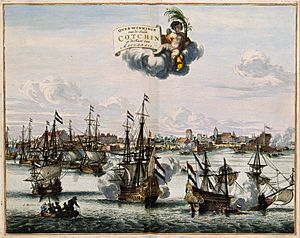
Even though Portugal was now fighting Spain, the Dutch East India Company kept attacking Portuguese bases. Malacca finally fell to the Dutch in 1641.
Important battles also took place in the South China Sea. The Dutch tried to capture Macau several times. They wanted to force China to trade with them instead of Portugal. However, they failed because of Portugal's long-standing good relations with the Ming dynasty. But the Dutch did manage to get the monopoly on trade with Japan.
The Dutch set up a colony at Tayouan (present-day Anping) in Taiwan in 1624. The Portuguese called this island Formosa. In 1642, the Dutch took northern Formosa from the Spanish.
The Dutch got involved in the Sinhalese–Portuguese War on Ceylon starting in 1638. They first allied with the Kingdom of Kandy against Portugal. The Dutch captured Batticaloa in 1639 and Galle in 1640. After some fighting between the Dutch, Portuguese, and Kandyans, the alliance was renewed in 1649. The Dutch eventually captured Colombo in 1656 and drove the last Portuguese from Ceylon in 1658.
Portugal managed to keep Diu, Goa, and Macau. But they lost Hormuz and Malacca. The Portuguese empire in India suffered more economically than territorially. Other European powers had more people, easier access to money, and more direct access to markets. This made Portugal's old trade system crumble.
Overall, the Dutch gained some Indonesian lands and a few cities and forts in Southern India. The biggest losses for Portugal were the capture of Malacca in 1641, Ceylon in 1658, and the Malabar Coast in 1663. These losses happened even after a peace treaty was signed in 1661.
The Sugar War in Brazil
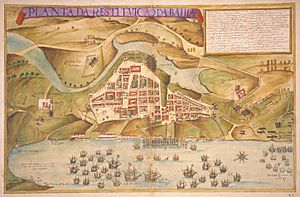
Seeing how easy it was to gain ground in Asia, the Dutch decided to attack Portugal in the Americas. In 1621, the Dutch West India Company (WIC) was created. Its goal was to control the sugar trade and colonize America. The company had a lot of money from investors. However, it was not as successful as the Dutch East India Company.
The Dutch invaded Brazil in 1624. They captured São Salvador da Bahia, which was the capital of Brazil. But the Dutch didn't hold it for long. In 1625, a large Spanish–Portuguese fleet quickly recaptured Salvador.
In 1630, the Dutch returned. They captured Olinda and then Recife, which they renamed Mauritsstadt. This created the Dutch colony of New Holland. The Portuguese commander, Matias de Albuquerque, moved his forces inland. He set up a camp called Arraial do Bom Jesus.
Until 1635, the Dutch couldn't harvest sugar because of Portuguese attacks. They were mostly stuck inside the cities. The Dutch eventually pushed out the Portuguese with help from a local landowner. But the Portuguese captured this landowner and executed him for treason.
The Portuguese fought off two Dutch attacks on Bahia in 1638. However, by 1641, the Dutch had captured São Luís. This gave them control of northwestern Brazil.
Rebellion in Pernambuco
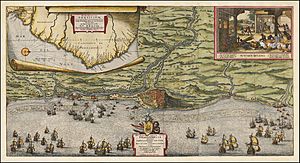
John Maurice of Nassau, the governor of New Holland, was called back in 1644. This was due to high spending and suspicions of corruption. The Catholic Portuguese and Protestant Dutch did not get along. The Dutch also took harsh measures to collect debts from landowners. This made the Portuguese settlers dislike the new Dutch government.
In 1645, most of Dutch Brazil revolted. A landowner named João Fernandes Vieira led the rebellion. He declared loyalty to the Portuguese Crown. The Dutch forces were defeated at the Battle of Tabocas. This trapped the Dutch mostly within the fortified cities along the coast. They were defended by German and Flemish soldiers for hire. That same year, the Dutch left São Luís.
The Second Battle of Guararapes in 1649 marked the beginning of the end for Dutch rule in Brazil. The Dutch were finally expelled from Recife in 1654.
Fighting in West Africa and Angola
At the same time, the Dutch attacked Portuguese lands in Africa. They wanted to control the slave trade. This was important to complete the trade triangle that would make their colony in Brazil successful.
In 1626, a Dutch attempt to take Elmina was almost destroyed by a Portuguese ambush. But in 1637, Elmina fell to the Dutch. In 1641, even after a truce was signed, the Dutch captured São Tomé. By the end of 1642, they had taken the rest of the Portuguese Gold Coast.
In August 1641, the Dutch formed an alliance with the Kingdom of Kongo and Queen Nzinga of Ndongo. With their help, the Dutch captured Luanda and Benguela. However, the Portuguese managed to retreat inland to strongholds. With a steady supply of slaves, the Dutch stopped fighting, thinking their allies could defeat the Portuguese. But Queen Nzinga and the Kongo lacked cannons and firearms. They could not defeat the Portuguese and their allies.
Recapturing Luanda and São Tomé
Portugal couldn't send many soldiers to their colonies. This was because of the ongoing Portuguese Restoration War back home. So, in 1648, the Portuguese governor of Rio de Janeiro, Salvador Correia de Sá, organized a military trip. He wanted to retake Luanda from the Dutch directly from Brazil.
In early August, the Portuguese fleet reached Luanda. De Sá told the Dutch that since they didn't respect the truce, Portugal didn't have to either. Even though the Portuguese were outnumbered, they showed their strength. On August 15, Luanda and all Dutch forces in Angola surrendered. When Queen Nzinga heard Luanda had fallen, she retreated. The Dutch on São Tomé abandoned the island, and Portugal reoccupied it later that year.
Peace Treaty of The Hague (1661)
The Dutch wanted to get back or keep their territories. They delayed the end of the conflict. But they also had to deal with the English at the same time. So, they eventually decided to offer peace terms. The Treaty of The Hague (1661) officially ended the war.
See also
 In Spanish: Guerra luso-neerlandesa para niños
In Spanish: Guerra luso-neerlandesa para niños
- Portuguese Empire
- United Provinces
- History of Portugal
- History of the Netherlands
- Dutch Brazil
- Spice trade
- 1640s in Angola
- Capture of Recife (1595)
- Colonialism
- Dutch East India Company
- Sea Beggars
- Ottoman-Portuguese conflicts
- Anglo-Turkish piracy -- Protestant sailors, including Dutchmen like Jan Janszoon or Sulayman Reis, joined the Barbary Corsairs during this period in order to raid ships of the Iberian Union and the Catholic monarchs.
- Liever Turks dan Paaps
- Ottoman naval expeditions in the Indian Ocean—in response to the presence of Europeans in the Indian Ocean after the voyages of Vasco da Gama & others, the Ottoman Empire undertook a series of naval operations to project power, and protect the Sunni Caliphate's merchants and pilgrims from Dutch and Portuguese privateers
- Black Propaganda against Portugal and Spain
- Ottoman expedition to Aceh



